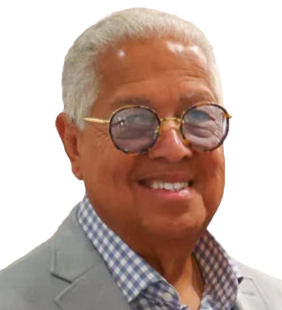BERNARD KINSEY
Co-Founder, The Kinsey Collection
“I’ve got a story for you.”
If you spend more than five minutes with Bernard Kinsey, 79, you’re guaranteed to hear this refrain, because he has thousands of stories.
For five decades, the gregarious collector and his wife, Shirley, 77, have amassed the Kinsey African American Art & History Collection, one of the world’s largest private collections of Black art and historical objects.
Lend him your ear and Bernard will tell you how he secured a 1963 typed letter from Malcolm X to Alex Haley after initially missing out on the auction where the correspondence sold, or he’ll describe the shivers he felt upon first opening a FedEx envelope that contained one of his earliest acquisitions, an 1832 handwritten bill of sale for an enslaved Black man.
These documents, among others, are on display in the Kinsey Collection Experience at SoFi Stadium, the first art installation to be displayed at the Inglewood sports and entertainment venue. Curated by their son Khalil, the creative director and general manager of the collection, the exhibit opened in February 2022 in honor of Black History Month and was extended an additional year. It will now be on view through March 2024.
Among the items on view along the arena’s wide Level 2 corridor are a copy of a 1595 baptism record from St. Augustine, Fla., and a 1773 book of poems written by the boundary-shattering poet Phillis Wheatley. There’s the World Series ring of Angeleno Emmett Ashford, the first Black umpire in Major League Baseball, as well as a 1924 photograph of 28 Black Los Angeles firefighters (“I didn’t believe there were that many Black firemen in L.A. today!” Bernard quipped of his 2021 purchase.)
From scientist Benjamin Banneker’s 1796 Almanac to a 2006 quilted portrait of a Black female fieldworker by textile artist Bisa Butler, there’s a trove of art and artifacts that speak to the strength, resilience, ingenuity and creativity of African Americans dating back to before the nation’s birth.
“As you see these objects,” Bernard said during a recent tour of the exhibition, “you’ll change your opinion of the African American story because everything we got in the history books didn’t have us in it. Khalil says it’s like being Photoshopped out of the picture.”
They’ve been on this collecting journey together since they got married in 1967. Both born and raised in Florida, they met as students at Florida A&M University. He is a retired Xerox executive who also co-chaired the Rebuild L.A. initiative in the wake of the city’s civil unrest in 1992. She taught at a Compton elementary school before becoming a Xerox training manager, then a project manager for an L.A. real estate development firm.
“We really worked for every dime of this,” Bernard said. Shirley echoes his sentiment: “We didn’t inherit this.”
“My whole entire upbringing, my parents were tour guides, essentially, sharing the power of these things they’d collected,” Khalil said. “[It was] never from a place of ‘Oh, look what we have!’” It was more of, ‘Look what you can do.’”

